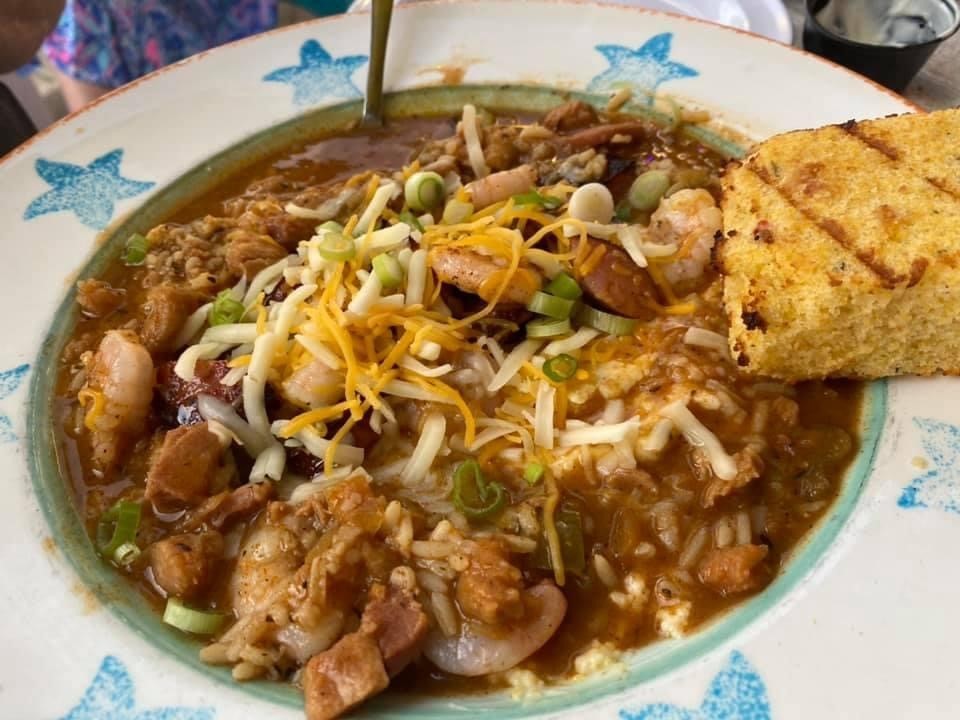
Full of influence from Spain, France, West Africa, and Louisiana, the Creole rice dish known as Jambalaya has made its way to the Pawley’s Raw Bar menu! This savory dish combines an assortment of meats, vegetables, and seasonings along with several other ingredients. In this month’s blog, we get into the history and flavors behind this melting pot of cuisines and cultures.
To start, let’s define what Jambalaya is. Jambalaya is a one-pot meal that is especially popular in the southeastern Gulf states, particularly Louisiana. Jambalaya is not a soup, nor is it a stew. It is a hearty mix of rice, vegetables, spices, and some combinations of meat, seafood, or both. There are two types of Jambalaya. Cajun Jambalaya traditionally includes ham, smoked sausage, and chicken and is made without tomatoes. Creole Jambalaya uses tomatoes and is more seafood-focused than meat-focused. Of course, over time, the two traditions have blended and borrowed from each other, and families have developed their own recipes. Each Jambalaya is different from the next. One might say that Jambalaya is as USA as food gets. It truly is a melting pot of cuisines and cultures.
Which came first? Creole? Cajun? That is one of those forever arguments like “the chicken, or the egg” that we cannot settle in a blog post, but it is interesting to see how similar dishes can be so different. The history of Jambalaya is like the history of Louisiana; rich. Cajun comes from French Catholic families expelled from Canada when they refused to convert to the Protestant faith. They resettled in the rural western lands outside of New Orleans and prospered as hunters and farmers. Hence the reason that Cajun Jambalaya is more meat-focused. Creole culture is centered in New Orleans and fully embraces a blend of French, Spanish, West Indies, and African cultures. Located closer to the Gulf, Creole Jambalaya includes tomatoes and a strong reliance on seafood. Creole Jambalaya is often called Red-Jambalaya.
Similar to low-country boils, Jambalaya was made popular during larger public gatherings like church fairs, political rallies, and family gatherings. These outdoor events were perfect for one-pot meals where people could stand around discussing ways to make their recipes better while they cooked. The dish traveled north during World War II. As southerners migrated to larger cities looking for work in war-production facilities, they took their recipes and flavors with them. This made Jambalaya popular all over the USA.
Cajun and Creole Jambalayas may contain similar ingredients, but they are cooked very differently. Cajun-style normally starts by browning the meats in a cast-iron skillet. Next, vegetables get added to the leftover bits, oil, and lard from the meat. Celery, red and green peppers, and onions are added and sauteed until they are soft. Some kind of stock is normally added at this point, the meat is returned to the pot allowed to simmer for a least an hour to thoroughly mix the flavors. The mixture is again brought to a boil as the uncooked rice is added. Reduce the temperature again and allow the rice to absorb the liquid.
The Creole version starts by sautéing the onions, celery, and peppers and then adding meat, tomatoes, other additional vegetables, and seafood. Then it is covered and simmered until everything is fully cooked. Stock and rice are added at the end in equal amounts before covering and simmering for about 30 minutes.
At Pawley’s Raw Bar, we serve the Creole style and we are sure you will love the combination of flavors that we have created for you. We have a table waiting for you. Why don’t you stop on by and give it a try!
Interested in taking a look at our menu before your visit? Check out our website here: https://pawleysrawbar.com/ You can find all kinds of cool things on our website like our location, more blog posts about your favorite restaurant, and links to our social pages like Facebook and Instagram. If you don’t follow us already, head on over to your favorite social platform and follow us for a healthy visual diet of the best Pawley’s Raw Bar has to offer!
